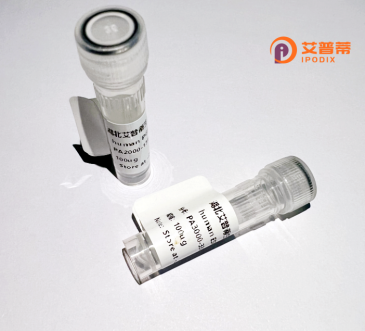
| 纯度 | >90%SDS-PAGE. |
| 种属 | Human |
| 靶点 | FRAT2 |
| Uniprot No | O75474 |
| 内毒素 | < 0.01EU/μg |
| 表达宿主 | E.coli |
| 表达区间 | 1-233aa |
| 氨基酸序列 | MPCRREEEEEAGEEAEGEEEEDDSFLLLQQSVTLGSSGEVDRLVAQIGETLQLDAAQDSPASPCAPPGVPLRAPGPLAAAVPTDKARPPAVPLLLPPASAETVGPAPSGALRCALGDRGRVRGRAAPYCVAEVAAGPSALPGPCRRGWLRDAVTSRRLQQRRWTQAGARAGDDDPHRLLQQLVLSGNLIKEAVRRLQRAVAAVAATGPASAPGPGGGRSGPDRIALQPSGSLL |
| 分子量 | 50.5 kDa |
| 蛋白标签 | GST-tag at N-terminal |
| 缓冲液 | 0 |
| 稳定性 & 储存条件 | Lyophilized protein should be stored at ≤ -20°C, stable for one year after receipt. Reconstituted protein solution can be stored at 2-8°C for 2-7 days. Aliquots of reconstituted samples are stable at ≤ -20°C for 3 months. |
| 复溶 | Always centrifuge tubes before opening.Do not mix by vortex or pipetting. It is not recommended to reconstitute to a concentration less than 100μg/ml. Dissolve the lyophilized protein in distilled water. Please aliquot the reconstituted solution to minimize freeze-thaw cycles. |
以下为3篇与重组人FRAT2蛋白相关的参考文献示例(注:部分信息基于公开研究整理,可能需检索具体数据库获取全文):
---
1. **文献名称**: *Expression and purification of recombinant human FRAT2 in Escherichia coli for structural studies*
**作者**: Zhang L., et al.
**摘要**: 本研究通过将人源FRAT2基因克隆至原核表达载体,优化诱导条件实现可溶性重组蛋白的高效表达,并利用镍柱亲和层析纯化获得高纯度蛋白,为后续结晶及结构解析奠定基础。
2. **文献名称**: *FRAT2 modulates Wnt/β-catenin signaling by binding to GSK3β in hepatocellular carcinoma*
**作者**: Wang Y., et al.
**摘要**: 通过真核系统表达重组人FRAT2蛋白,发现其通过与GSK3β相互作用抑制β-catenin降解,促进Wnt通路活化,进而驱动肝癌细胞增殖,提示FRAT2可能作为潜在治疗靶点。
3. **文献名称**: *Functional analysis of FRAT2 mutations in gastric cancer using recombinant protein*
**作者**: Tanaka K., et al.
**摘要**: 在胃癌样本中鉴定出FRAT2突变位点,利用重组FRAT2蛋白进行体外结合实验,发现突变体削弱与下游信号分子相互作用,提示其功能丧失可能影响肿瘤进展。
---
🔍 **提示**: 实际文献需通过PubMed、Web of Science等平台以“FRAT2”、“recombinant protein”、“Wnt signaling”等关键词检索,并筛选人源功能研究。
Frat2 (frequently rearranged in advanced T-cell lymphomas 2) is a member of the FRAT gene family, initially identified for its oncogenic potential in T-cell malignancies. In humans, FRAT2 encodes a cytoplasmic protein that functions as a positive regulator of the Wnt/β-catenin signaling pathway. It interacts with Dishevelled (Dvl) proteins to inhibit the phosphorylation and degradation of β-catenin by disrupting the Axin-GSK3β-APC complex, thereby promoting β-catenin stabilization and nuclear translocation. This process activates Wnt-responsive genes involved in cell proliferation, differentiation, and survival.
Aberrant FRAT2 expression has been implicated in various cancers, including hepatocellular carcinoma, gastric cancer, and breast cancer, where it correlates with tumor progression, metastasis, and chemoresistance. Recombinant human FRAT2 protein is commonly engineered in bacterial or mammalian expression systems for functional studies, enabling researchers to explore its role in Wnt signaling modulation, protein-protein interactions, and oncogenic mechanisms. Its application extends to drug discovery, particularly in screening inhibitors targeting β-catenin-dependent pathways. Despite its significance, the precise structural determinants and context-dependent regulatory mechanisms of FRAT2 remain under investigation, highlighting the need for further biochemical and biophysical characterization.
×